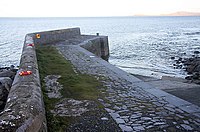
Kilfenora is a village and a civil parish in County Clare, Ireland. It is situated south of the karst limestone region known as the Burren. Since medieval times when it was the episcopal see of the Bishop of Kilfenora, it has been known as the "City of the Crosses" for its seven high crosses. The village had around 220 inhabitants in 2011. Much of the TV show Father Ted (1995–98) was filmed there.

Carran, also Carron, is a small village in County Clare, Ireland. It is in the Burren region, within a civil parish of the same name. It is notable mainly for being the birthplace of Michael Cusack, the inspirer and co-founder of the Gaelic Athletic Association. At the time of the 2011 Census, Carran had 106 inhabitants.

Kilshanny is a village and a civil parish in County Clare, Ireland.

Tubber is a village in the north of County Clare, Ireland.
Murroogh, sometimes named Murrooghtoohy or Murroghtwohy, is a hamlet in County Clare, Ireland. It covers the townlands of Murrooghtoohy North and Murrooghtoohy South. It is within the civil parish of Gleninagh, in the Barony of Burren. The area was officially classified as part of the West Clare Gaeltacht; an Irish-speaking community; until 1956.

Kilfenora Cathedral is a cathedral of the Church of Ireland. Part of the structure is occasionally used as a place of worship by the Church of Ireland and it includes a bishop's throne among its furniture. The church is located in the village of Kilfenora, in the region known as the Burren, County Clare, Ireland. In medieval times, it was the episcopal see of the Bishop of Kilfenora.

Newtown Castle is a 16th-century tower house, located close to the village of Ballyvaughan within the Burren area of County Clare, Ireland. Uniquely for a tower house of its type in Ireland, it is cylindrical in shape above a square pyramidal base. It is today part of the Burren College of Art.
Kilmoon is a civil parish of County Clare, Ireland, 7 miles (11 km) north of Ennistymon. The parish contains the town of Lisdoonvarna.
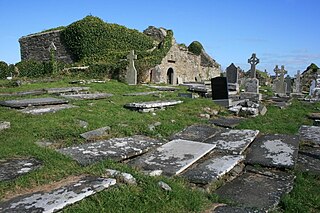
Kilmacrehy, sometimes also Kilmacreehy, is a civil parish in County Clare, Ireland. The ruins of the old parish church lie near the coastal village of Liscannor, which is also a part of the parish.

Rathborney, sometimes Rathbourney, is a civil parish in the Barony of Burren in County Clare, Ireland.
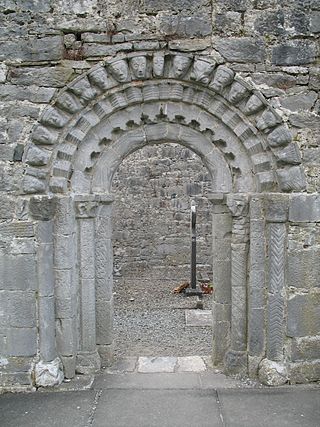
Dysart and Ruan is a Catholic parish in County Clare, Ireland. It covers the civil parishes of Ruan and Dysert, and includes the village of Ruan, which holds the parish office. The parish contains the ruins of the 12th century St. Tola's Church, part of Dysert O'Dea Monastery.
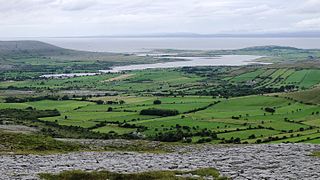
Oughtmama is a civil parish in County Clare, Ireland. It lies in the Burren, a region in the northwest of the county. It contains many antiquities, including three early-medieval Christian churches, ruined castles, prehistoric cairns and ring forts and two Martello Towers built in the early 19th century.

Killilagh or Killeilagh is a civil parish in County Clare, Ireland. It contains the village of Doolin.

Noughaval or Nohoval is a civil parish in County Clare, Ireland.

Drumcreehy or Dromcreehy is a civil parish in County Clare, Ireland. It contains the village of Ballyvaughan.
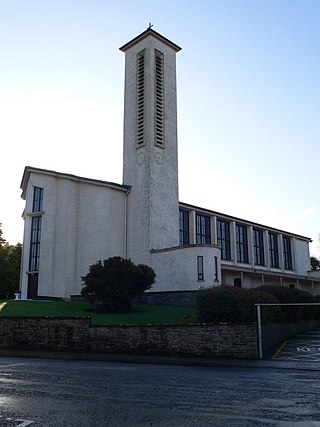
Kilmanaheen is a civil parish in County Clare, Ireland. It contains the market town of Ennistymon.
Killeany or Kilhenny, Kilheny is a civil parish in County Clare, Ireland. It lies in the Burren region of the northwest of the county.

Kilcorney is a civil parish in County Clare, Ireland. It lies in the Burren region of the northwest of the county.

Inagh and Kilnamona is a parish of the Roman Catholic Diocese of Killaloe in County Clare, Ireland. It is mostly coterminous with the civil parishes of Inagh and Kilnamona that lie to the west of the county town of Ennis in the ancient barony of Inchiquin. The parish contains two churches and an oratory.
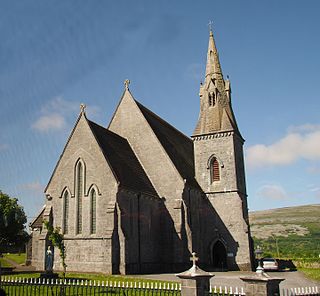
Ballyvaughan parish is a Catholic parish in County Clare, Ireland, and part of the Kilfenora Deanery of the Roman Catholic Diocese of Galway, Kilmacduagh and Kilfenora. It is located in the northern side of The Burren, bordering Galway Bay. As of 2021, the parish priest was Richard Flanagan.








